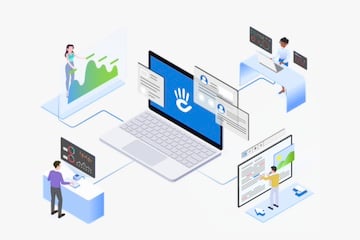Content management systems help you build and modify websites without coding and create, manage, and modify online content.
Here is a list of open source content management systems. Many of the systems have large developer communities and thousands of themes and extensions. The basic systems are free, but most offer premium add-ons and paid plans for hosting services.
WordPress
WordPress It was launched as a blogging platform in 2003. Today, it is a sophisticated CMS built with PHP and MySQL that powers around 40% of the world’s websites, from hobbyist blogs to the largest news portals. Over 70,000 free plugins and themes help you customize your WordPress installation. E-commerce featuresgalleries, mailing lists, forums, analytics, security and more.
–
gravity
gravity is a CMS that emphasizes speed, simplicity, and flexibility. Grav is written in PHP, is based on the Symfony framework, and uses Twig for templating. It comes with a package management system that makes it easy to install and upgrade plugins, themes, and the platform itself. It features a minimal learning curve and an easy-to-follow way to create content. You can create blogs, websites, landing pages, portfolios, e-commerce sites, and more.
–
Dorpal
Dorpal is a free and open source content management system and framework. It has standard features such as easy content creation, reliable performance, and security. It is highly modular and extensible, with about 40,000 modules that extend the functionality of your site and 2,500 themes that change the look and feel of your site. Users can easily create sites, online stores, social networks, blogs, wikis, and more. Drupal Community It has over 1 million members. Many government agencies in the US, UK and France, as well as media companies such as NBC and BBC use the Drupal platform.
–
Typo 3
Typo 3 It is a free, open source CMS based on PHP that provides complete support for marketers, from content planning and modeling to smart workflows. Digital Assets management, Search Engine OptimizationAnd more. Create and publish content across multiple sites, multiple languages, and all digital channels while maintaining control with role-based access. Build information-rich digital experiences that perform well at any scale.
–
Joomla
Joomla is a free, open source CMS that is mobile-friendly, search engine friendly, multilingual, flexible and has over 5,000 extensions. It can be used for small business websites, e-commerce, online booking, corporate websites, online publications, government and non-profit sites. Joomla is built on the Model View Controller web application framework, allowing you to build online applications, integrated e-commerce systems, data reporting tools and much more. Inventory Management systems, communication tools, etc.
–
Umbraco
Umbraco is a flexible CMS built on the .NET Framework. Optimized for content creation and management, the intuitive interface allows editors to perform daily tasks, preview and publish content, schedule campaigns, and more. Create and manage content in multiple languages for different channels and reuse content wherever you need it: blog posts, mobile app data, promotional campaigns, and more. Umbraco comes with over 300 extensions and plugins and a support community of over 220,000 members.
–
Concrete CMS
Concrete CMS is an open source CMS for content creators, designers and developers. Its modular and extensible platform makes it easy to build and run websites. Concrete CMS features in-context editing, WYSIWYG content editor, modular blocks, form builder, integrated reporting, integrated commenting system, collaborative controlled access, advanced security and thousands of themes and add-ons to extend its functionality.
–
Silver Stripe CMS
Silver Stripe CMS is an easy-to-use CMS with a front-end templating engine, a customizable framework, and an extensive list of modules to extend its functionality. Create custom fields, page types, data structures, and logic. Launch campaign pages directly from the CMS without a time-consuming development process. SilverStripe CMS has over 2,500 modules and over 50,000 live sites.
–
Craft CMS
Craft CMS is a flexible, user-friendly CMS for creating custom digital experiences. Craft offers separate building blocks for different types of content. Choose the features you need and update your content using Craft’s built-in administration features. Build and manage your e-commerce store, Checkout flowrun promotions, set shipping rules, and more. Craft’s templates are powered by Twig, a templating system by the creators of Symfony. The Solo plan is free for self-hosted sites.
–
Contao
Contao is an open source CMS and framework for creating scalable web applications. Contao Manager, a graphical interface for Composer, allows users to install and manage frameworks and extensions directly in the browser. Contao has multiple backend capabilities: language Advanced editing, permission system, multiple page types and websites in one tree, flexible form generator, advanced search options, built-in modules, extensions, etc. Contao uses a password hashing algorithm and supports user accounts with two-factor authentication.
–
Open Cart
Open Cart is an open source CMS for e-commerce. Use the modern and responsive default theme or choose from thousands of themes from third-party providers. OpenCart includes a variety of themes for products, orders, Customer Managementsales reports, Marketing Toolsand there’s an active support community. OpenCart has over 14,000 extensions available for download.
–
Backdrop CMS
Backdrop CMS Backdrop is an open source, easy-to-use CMS for small businesses, non-profits, or organizations that need a comprehensive website for free or at low cost. Use Backdrop CMS for anything from a personal blog site to a complex, multipurpose e-commerce platform. Backdrop is easily extendable with modules, themes, and layouts. Backdrop CMS is a Dorpal 7,Maintaining code with proven success.


















